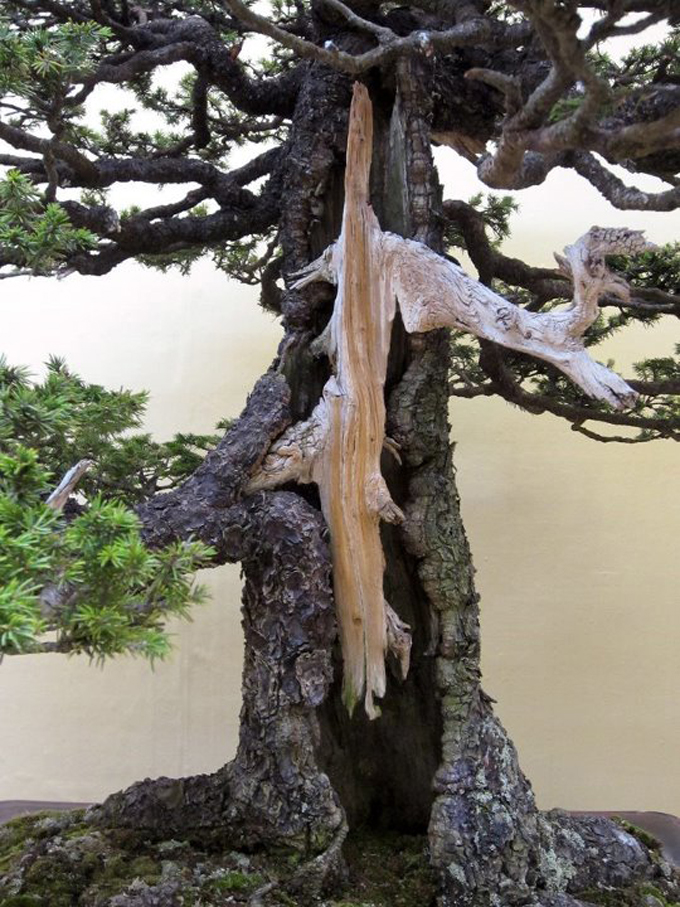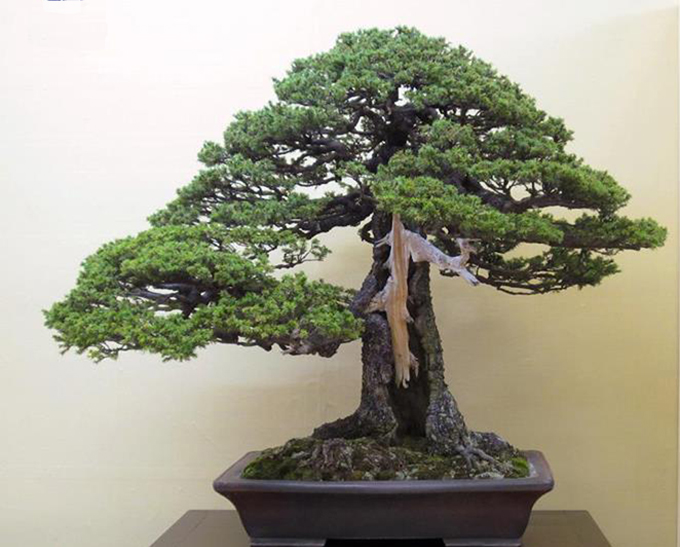 Hanging out. Or just hanging in? I don’t know if I’ve ever seen a shari quite like this one; it seems to be floating in the opening of the sabamiki (trunk’s hollow). Still, I think this would be a wonderful tree even without the shari; the sabamiki, the nebari and the superbly textured bark all create a powerful sense of age and character. I found both photos shown here at Michael Bonsai. They are originally from Bonsai Tonight.
Hanging out. Or just hanging in? I don’t know if I’ve ever seen a shari quite like this one; it seems to be floating in the opening of the sabamiki (trunk’s hollow). Still, I think this would be a wonderful tree even without the shari; the sabamiki, the nebari and the superbly textured bark all create a powerful sense of age and character. I found both photos shown here at Michael Bonsai. They are originally from Bonsai Tonight.
Does the shari draw your attention to, or distract from, an otherwise magnificent trunk?
What would happen if you removed the shari on this ancient looking Ezo spruce? I’d guess that you’d be left with one of best sabamiki anywhere (if look at the photo below you’ll see how it stretches all the way from the ground to where the trunk disappears behind the foliage).
Still, I wouldn’t do it. The shari is just so damn unique, the way it demands your attention. Too bad we can’t have two trees like this; one with the shari and one without it. Then we could put them side by side and see what’s gained and what’s lost. Or maybe some photoshop maven can do it for us.
 Can you imagine the tree without the shari? Photos by Jonus Dupuich, Bonsai Tonight.
Can you imagine the tree without the shari? Photos by Jonus Dupuich, Bonsai Tonight.
Wow! That looks so far outside the mainstream of what humans will come up with that I almost have to think it was copied from a tree in the wild. (Not that I would object to that!) In any event, the whole tree looks *very* naturalistic to me.
I think this one is a bit of an acquired taste because it’s so far outside the ‘norm’ of what we usually see with bonsai and sharis. I think I would prefer to have it without the shari because my eye is taken straight to it and I miss all the other wonderful things about this beautiful tree.
My opinion: I would ditch the white shari too. Looking at the story of the tree, a conifer typically loses the center of its trunk to fire. Any remaining wood should be black, gray, or otherwise muted if it hadn’t been burned off. White jins and sharis simply do not accurately reflect the look of all dead wood in nature. If you’ve ever stood inside a giant redwood, you might agree. I do like the Kimura pine that has a comparable treatment, because it looks somehow rotted and doesn’t poke you in the eye like this one does. The question is begged: How did that bleached section survive whatever took out the center of the tree? The section should be supported at its lower end and it seems to be suspended unnaturally. Without the bleached section, this Ezo spruce would be a very compelling tree with a lot of “gyo” to it.
Prehistoric creature inside the sabamiki——-
Thanks Ann and Steve for your somewhat similar takes.
I’m not sure that outside the mainstream or norm is a problem, though I do get your drift.
Perhaps the best thing about the shari is the response it provokes. It’s good to read all the comments.
Beyond that, there something about features that tell the story of tree. Sometimes we are tempted to remove those very features because they don’t conform to our notions of how a bonsai should look.
Hi Al,
Thanks. You’ve presented a very sound case for removing the shari. And agreed, it would be a very compelling tree without it.
Hi Nuromeo,
Yeah, there is a sort of creature quality to the share. Even though it’s just deadwood, it seems to have taken on some life, at least judging by the comments.
I have seen this wonderful tree many times over my lifetime. I think it’s a piece of drift wood found on the beach and carved a bit to fit. A kind of tanuki on the small scale. I am sure I am wrong. I have to be.
Not that there is anything wrong with that.